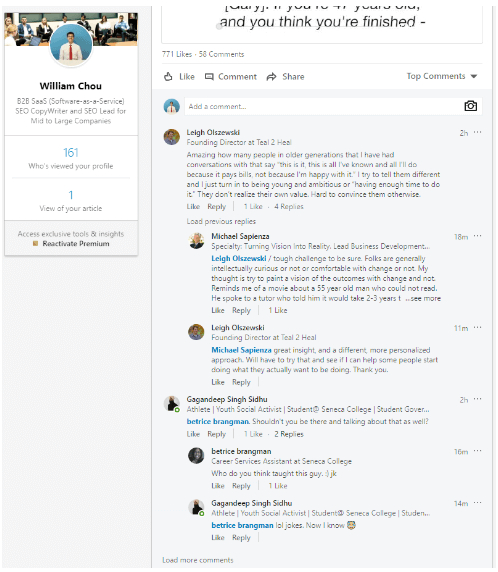
10 B2B digital marketing trends that are transforming business
There are two possibilities: you’re ahead of or behind the times. One makes you money, the other loses you money.
I’ll get you into the group with the money by sharing the top 10 B2B digital marketing trends for 2018.
1. Deeper personalization and interactive marketing
Personalization is at the top of the list of B2B marketing trends to watch.
With the arrival of big data, companies can get more details about their customers than ever before. When you combine this with the power of the Internet, you get faster feedback loops and greater customization.
In fact, if you aren’t adding in personalization, you’re not keeping up with the standards of effective B2B marketing.
Prospects and customers love personalization because people believe their problems and situations are unique. They would rather do business with someone who can understand their problems, thoughts, hopes, fears, dreams, relationships, and lifestyle better than themselves.
Marketing will also get more interactive and tailored to specific individuals with the advent of virtual reality devices, like the Oculus Rift and HTC Vive, mass-market drones, and 360 degree video cameras.

Soon, marketing will have the ability to trigger visual experiences that the mammalian part of your brain can’t distinguish from reality.
This may result in marketing messages that hit home at a deeper level than ever before because advertisers can tell us a story and create an experience in a lot more detail than ever before.
Finally, account-based marketing (ABM) leads the pack of current digital marketing trends.
What is ABM?
If you’re unfamiliar, ABM is a form of marketing that hyper-targets a small audience with extreme personalization. This works well for B2B. A few sales can make or break a company’s profits for the year because the sales are high-ticket.
Since the audience you’re targeting is smaller, you are able to get hyper-specific with your messaging and the ad won’t feel like it’s excluding anyone.
Just be careful to not get so personal in your messaging that it creeps out prospects because of how much you know about them.
B2B ABM, though a new phenomenon, has already come far. The main difference in targeting capabilities between ABM and B2C search engine marketing lies in the robust professional data you can use.
It allows for you to create customized experiences based on:
- Job title
- Industry
- Revenue
- IP address
- Email behavior
- Where they live
- Company they go to
- Number of employees
- Website visitor data and behavior (forms filled out, pages they visited)
2. Marketing Automation
Prospects and customers always want valuable content delivered to them that is personalized to their unique frustration and fears, while being delivered as conveniently as possible.
With so many different people in the world with different hopes and dreams, you could only hope to get to a certain level of segmentation and personalized messaging.
With marketing automation, you can deliver that personalized content to them at the right time without having to do it yourself. You can set it up and let it run on its own to personalize messages based on demographics, user behavior and more.
There’s less guessing and more data-driven decisions than ever before. Just make sure you leverage it; just because it exists doesn’t mean B2B marketers are leveraging the data to make their best decisions yet.
A word of warning:
While marketing automation can improve efficiency and customer satisfaction, it can also reduce the customer experience. When you start salivating over everything you can outsource with automation, you can end up delivering content that doesn’t match your prospect’s desires with inaccurate automation.
Email marketing is still king
B2B online marketing trends don’t have to be new. It can also be what’s old but still working like magic.
Long-standing internet marketers have preached for years that the “money is in the list.” And it is still true.
When you send emails, you are getting the most affordable ROI because the cost for marketing to and building a relationship with your prospects is a bargain.
The bare basics that allow you to be dangerous in the competitive game of B2B business includes building your email list and having basic segmentation.
If you don’t have prospect segmentation yet, start with prospects versus existing buyers and a tailored follow-up sequence based on these two segments.
Chatbots & Facebook messenger bots
New forms of marketing automation are popping up every couple years. Lately, automated chat box sequences and Facebook messenger bots are all the rage.
The function is similar to email automation and creates customized follow-up messages based on the topics the user mentions he or she cares about.
To get started with Facebook messenger marketing, check out Manychat, one of the top Facebook messenger services.
If you don’t keep growing with your B2B Facebook marketing strategy, you’re going to get left behind.
3. Content marketing
Content marketing is still the keystone to attracting and winning over the trust of your ideal prospects.
Rather than the “push-themed” marketing and advertising of the past, which is intrusive and not welcomed, content marketing done well “pulls” your ideal customers to you. The best part?
There is no complaining or pushback during the process.
But the most successful marketers prepare a successful B2B content marketing strategy. The mediocre follow a “spray-and-pray” method with no direction.
Content marketing comes in many forms. There are infographics, animagraphics (animated infographics), Instagram stories, podcasts, blog articles, and more.
But when you boil it down, there are just three forms:
- Text
- Audio
- Visual
The Internet has done a great job of mastering the first form. Out of all the B2B content marketing trends, video offers the most opportunity because of its untouched pastures.
4. Video marketing
WebMechanix has been spearheading video marketing because it is clearly the future of B2B digital advertising.
Large social media platforms are making an obvious push for video by adding various organic video capabilities into their platform.
- LinkedIn has launched organic video uploads in status posts that are self-hosted on its platformed (currently with a 10 minute cap, which is quite a length).
- Instagram has pushed out Instagram Stories, allowing these stories to be hashtaggeable, and lengthened their video length for videos posted on profiles to 1 minute.
- Facebook has added the ability to add titles and tagging to videos you upload, as well as Facebook Stories and Facebook Shows, clearly prepping for the launch of their own video search engine.
- YouTube has launched live streaming capabilities.
Moreover, they’re all clearly favoring video and live streamed content over regular text content in their organic feed algorithms because there’s a lack of video content on their platforms.
The visual part of content marketing is reaching a point of exponential growth like we’ve never seen before, especially with virtual reality, which we mentioned earlier.
So what are you waiting for? Jump on board before you get left in the dust.
5. LinkedIn Ads
We’ve mentioned LinkedIn, but it deserves its own section.
B2B marketers are still confused with how to use it effectively. They’re still only dipping their toes in the water.
Mastering LinkedIn is tough. The CTR’s are lower than Facebook ads and CPC’s are higher. But there’s gold to be had.
It’s the largest, active social network for professionals and real people are engaging on there every day. I check my LinkedIn feed often and many of the posts get verifiable comments from real business leaders.

LinkedIn has launched its pixel, which will allow for retargeting and robust customization.
LinkedIn leads are higher quality so it makes sense that they’re more expensive. Don’t let its cost fool you. There is a gold mine here for B2B.
Who will crack the code for LinkedIn ads first?
6. Storytelling
Storytelling is a timeless art that has helped make billions of dollars in the music, film, and advertising industries. It’s a fantastic way to keep a prospect’s attention, get a message across, persuade, build trust, and have him or her remember it.
B2B companies haven’t realized how effective it can be in their industry and are just starting to use it more frequently.
Do your ads and messaging have a story structure or are they just relaying information? If it’s the latter, you could be missing out on a huge opportunity.
B2B storytelling is here to stay and others have already started using it.
7. Artificial intelligence (AI)
The most exciting development in B2B digital marketing trends is AI.
Its sophistication grows exponentially every year. What this means for B2B is that machines and algorithms will be adapting to human search behaviors and user interactions to produce increasingly accurate and helpful content and services.
Big names, like Mark Cuban, have come out and said how artificial intelligence will dwarf all the other revolutions that have occured.
“What we’re going to see with artificial intelligence — dwarfs all of that.” -Mark Cuban
The reason this isn’t higher up on the list is because we’re still in the infantile stages of AI.
Great contextual understanding
Google and YouTube are powerhouse search engines that are becoming more and more contextual with their search results.
Rather than simply using text to find the best results for a phrase like “video game systems like XBox”, it will incorporate past user search behavior and contextual triggers to bring up the right phrase.
Not only does this reduce the effectiveness of keyword stuffing pages, an old school SEO tactic, it also means that users will find the content they want even if they only have a piece of information to go on, like “the song with Selena Gomez where she can’t get someone off her mind.”
Voice
AI voice services, like Alexa, Siri, Google Home, are standing on top of Google’s search algorithm to deliver content to you without you ever having to do more than say something out loud.
The rising accuracy and possibilities with these services and its integrations hold some mystery. Where will this lead? What other ways can we use this that businesses haven’t thought of yet?
Since these services pull the first result of searches, this can speak to the greater importance of ranking #1 and the reduced importance of any other ranking.
Related to voice services are podcasts. A larger percentage of the population are listening to podcasts every year during their drives and wait time. This is a fantastic opportunity to occupy market share and mindspace in a new frontier.
Be on the lookout for where you can leverage voice and stay ahead of the pack. Because if you’re not growing, you’re dying — and you can count on your competitors doing so if you don’t.
Check out the “Audio version” button at the top of this article. We implemented a simple WordPress plugin and paid a few cents through Amazon Polly to transcribe this post and convert it into an audio service.
Machine learning and greater features
The beauty of artificial intelligence and machine learning is that it self-teaches and becomes “smarter” over time.
For example, Google adapts to search queries by offering contextual results, like Quick Answers, local boxes, and other dynamic search futures based on your search (depending on if it’s a local search, cooking search, etc.).

8. Smartphone usage is still growing
For years, marketing authorities and social media platforms have been pointing to the stats behind mobile vs. desktop to prove how important mobile is. Many saw the growth. Some thought it would stop at 50/50.
But it’s grown beyond that point.
You’re probably already aware of this. But did you know that mobile pages that load in 2 seconds instead of 3 experience a 27% higher conversion rate?
It’s not always the fancy stuff that gets you ahead, it’s making sure you have the basics down — which many people often forget to do.
Our own marketing data points to the fact that users in B2B stumble across content and ads through mobile but tend to convert more often on desktop. Therefore, it may be best to emphasize desktop engagement when you’re focusing on the final conversion point.
As far as B2B mobile marketing trends are concerned, both platforms should now be playing a large role in your marketing strategies. Make sure the basics are covered. Are your sites mobile-responsive and fully functional?
9. Live streaming
Speaking of live streaming, this is another huge trend you cannot ignore.
Live streaming goes beyond streaming video games on Twitch. It includes live webinars, Facebook Lives, Instagram Lives, Twitter Live, Google Hangouts, and YouTube streaming on your channel. Likely, more platforms will emerge in the future, such as LinkedIn Live.
We’re still in the infantile stages of what the internet will offer so it’s important to be prepared and well-versed with live streaming equipment, software, and protocol when it hits big with a new platform.
It’s not as complicated as you think. Social media apps have made it as simple as touch of the button and Google Hangouts offers a free option if you don’t want to pay.
If you’re interested in something paid and more reliable, check out GoToWebinar.
Many B2B SaaS have already been aware of the ROI with live webinars and have been conducting them once a week or more. The reason is simple:
There’s not a better way to build trust and make high-ticket sales to a large audience at once than a webinar. People can engage with you in real-time to see what you’re like.
The early adopters are already firing hard — will you join the pack?
10. Partnerships and collaborations
In B2B, partnerships are critical.
One or two partnerships can drive the bulk of sales. While losing a relationship can be devastating, winning another can be twice as nice.
So relationship management is essential.
Beyond sales, forming key relationships helps immensely with::
- boost traffic
- increase referrals
- scale your business
- unearth management, recruiting, and other business opportunities
So how do you do form these relationships?
Try Russell Brunson’s Dream 100 methodology.
List 100 of your dream influencers, thought leaders, and/or partners. Reach out and develop these relationships over time by giving value with no expectations.
Many, if not most, will ignore you or decline to collaborate or promote for you. But if you get just a few, that’s enough to make a major impact on your business.
Once you start building momentum, like a snowball rolling down a hill, the rest will follow. Others will see your value and start partnering with you. Traffic, links, and sales follow.
Conclusion
According to Gary Vaynerchuk, a social media marketing expert and entrepreneur, B2B share a core theme with B2C since it’s all P2P (people-to-people).
But there are clear differences that you need to be aware of. B2B’s low traffic, high-ticket sales means that you’re just one relationship away from changing your business.
Interactions are more important and valuable so you have to make sure you make the most of each one. By taking these B2B digital marketing trends by the balls, you can do that.
We’re a B2B internet marketing agency that has been helping companies in the space for years. Check out our PPC services to learn more about us.
What’s your most and least favorite trend of 2018?
View all posts filed under “Social Media”
Back to the main blog overview
Learn about the B2B marketing services that we offer on our About page
Most newsletters suck...
So while we technically have to call this a daily newsletter so people know what it is, it's anything but.
You won't find any 'industry standards' or 'guru best practices' here - only the real stuff that actually moves the needle.






